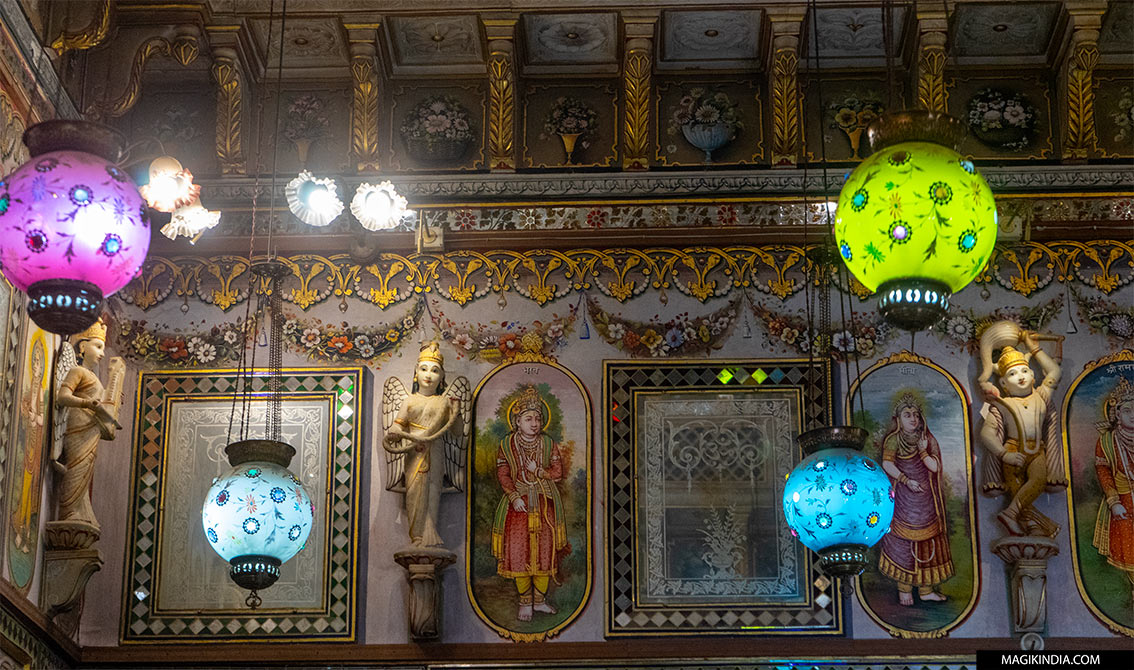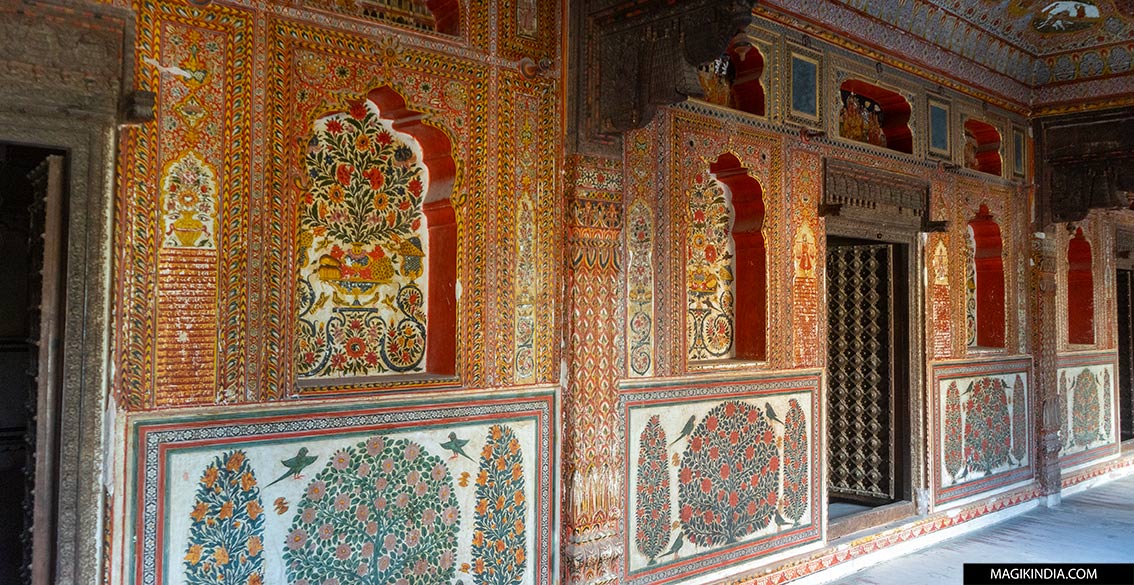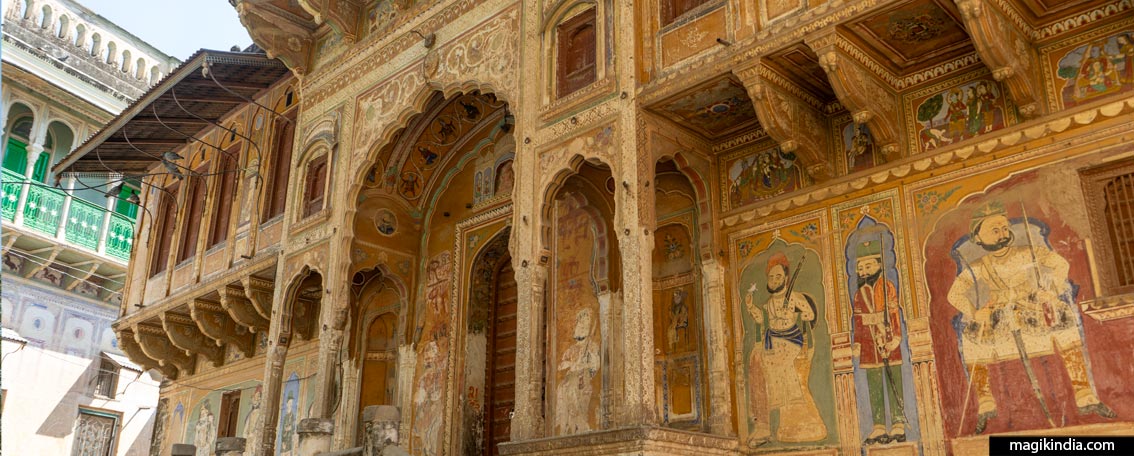
Nawalgarh, the golden city of Shekhawati
Nawalgarh is a major city in Shekhawati, a semi-desert region in northern Rajasthan. Founded in the mid-18th century, it became one of India’s most prosperous cities in the following century thanks to the “Marwaris,” merchants who made their fortunes on the Thar Desert trade route and later in various industries based in Mumbai and Kolkata. Its nickname, the “City of Gold,” refers to this former wealth. The Marwaris displayed their opulence by building palatial mansions adorned with lavish frescoes. Many of modern India’s wealthy business families, such as the Podars, Birlas, and Goenkas, to name a few, are direct descendants of the Marwaris of Nawalgarh.
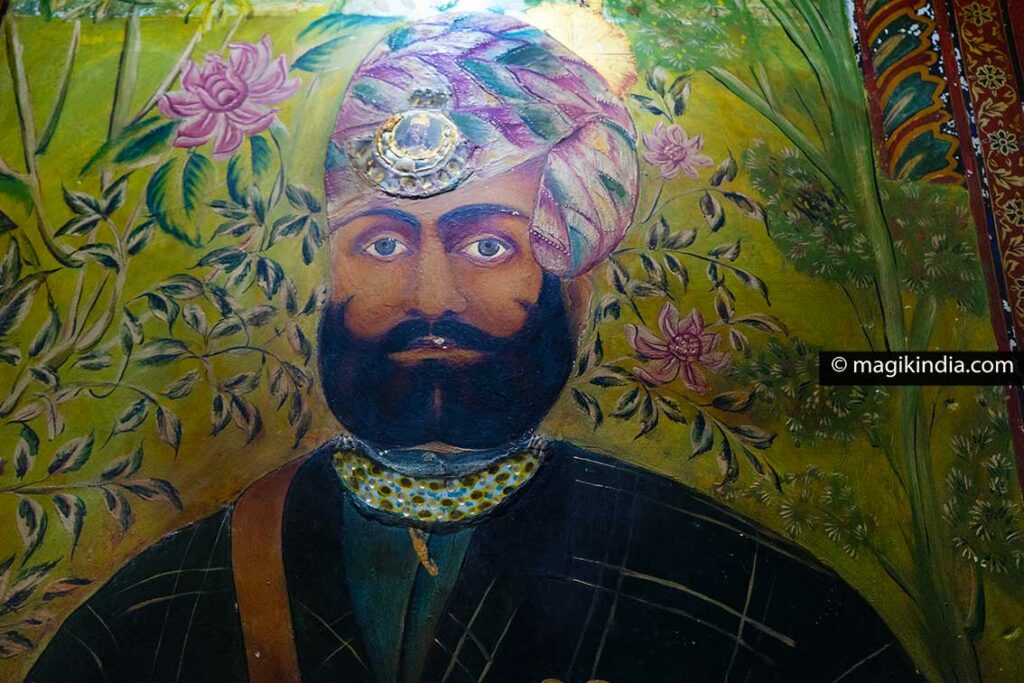
Nawalgarh was founded in 1737 by Thakur Nawal Singh Ji Bahadur of the Shekhawat dynasty; his descendants ruled there until the abolition of fiefdoms in Rajasthan.
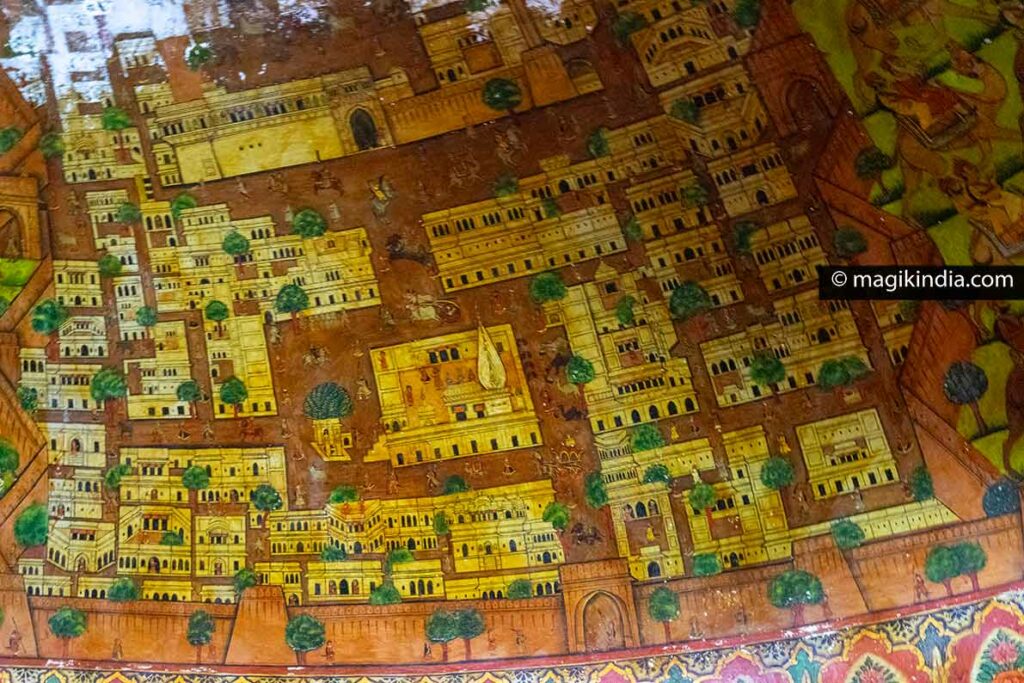
The city was then surrounded by high walls consisting of four pols (gates) and two forts, the Bala Kila located in the center of the city and the Fatehgarh Fort located outside as an outpost. With its planned streets, Nawalgarh was considered the most modern city in Shekhawati.
Of the Bala Kila, only a mirrored boudoir (sheesh Mahal) remains, which I describe in another article. The ramparts and the fort of Fatehgarh are no more than a memory; only the havelis (mansions), a few temples, and kua wells have stood the test of time.
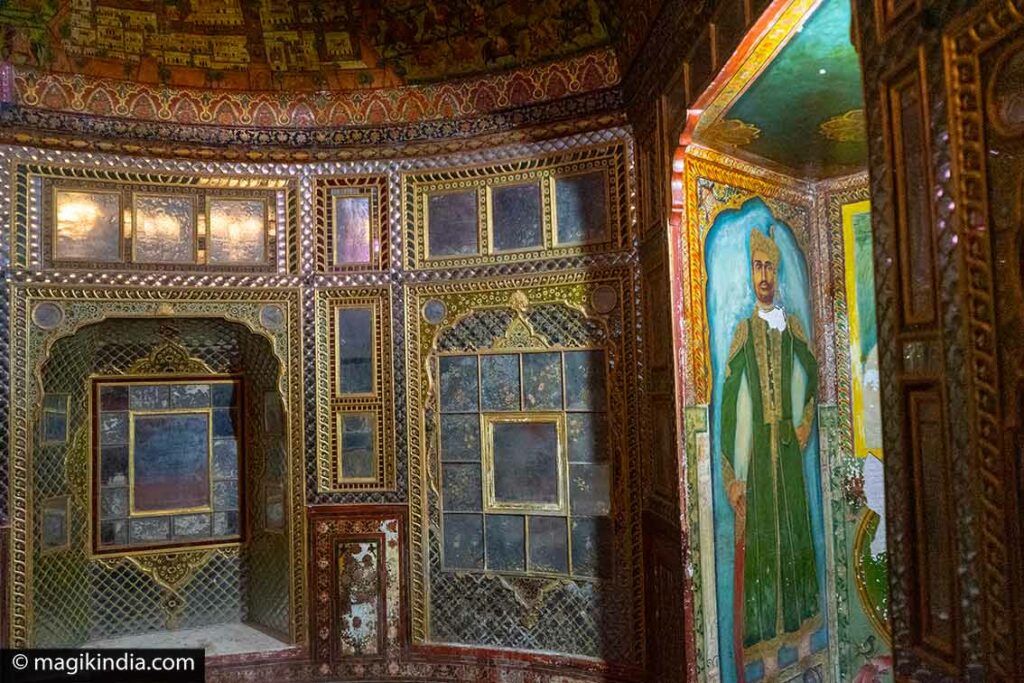
The main havelis of Nawalgarh
Nawalgarh is renowned for its splendid mansions built by wealthy Marwari merchants from the 19th to the early 20th centuries. There are over 600 of these throughout the city, most of which have sadly fallen into disrepair. A handful have been restored, and only three are open to the public: Podar Haveli, Morarka Haveli, and Bansidhar Bhagat Haveli.
Podar haveli
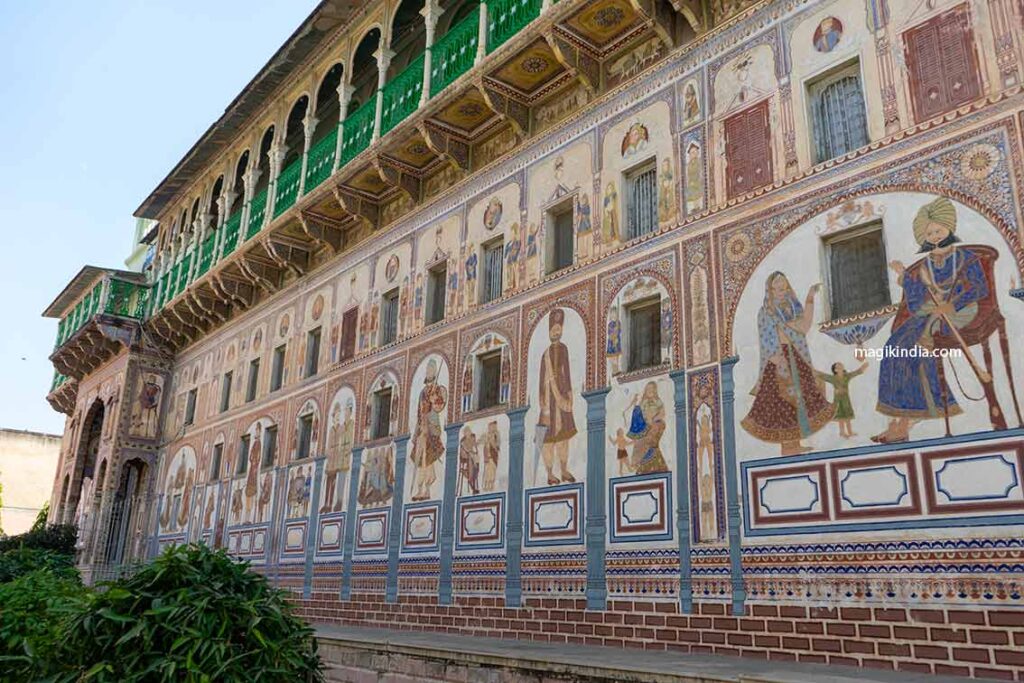
Let’s start with the most famous haveli in Nawalgarh, the Podar haveli in the west of the city.
This haveli was built in 1902 by Sheth Anandilal Podar, a prominent Marwari businessman from Mumbai with interests in cotton mills. In 1927, he founded the Podar Group of Schools Trust, and the haveli was subsequently used as a school in 1955. In 2007, his grandson, Kanti Kumar Podar, converted the haveli into a museum and named it the Dr. Ramnath A. Podar Museum in tribute to his father.
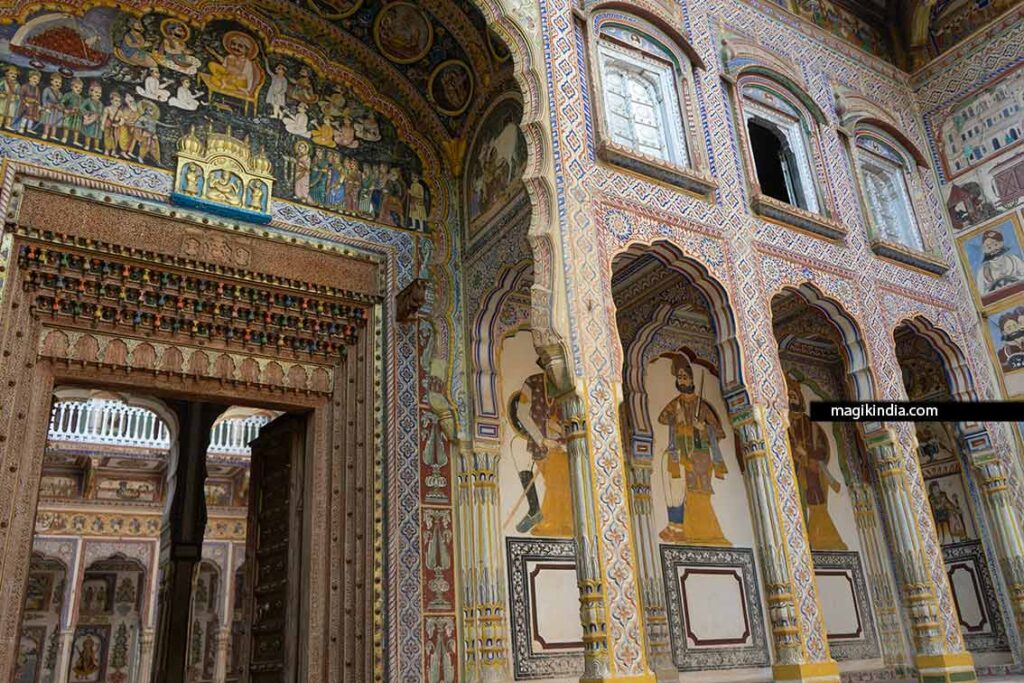
The unique feature of this haveli is the number of its frescoes: 750 in total! They illustrate different themes such as the deities of Hindu mythology (Radha-Krishna in particular), the Indian epics of the Mahabharata and the Ramayana and some contemporary elements such as the steam train and the first hand-cranked cars.
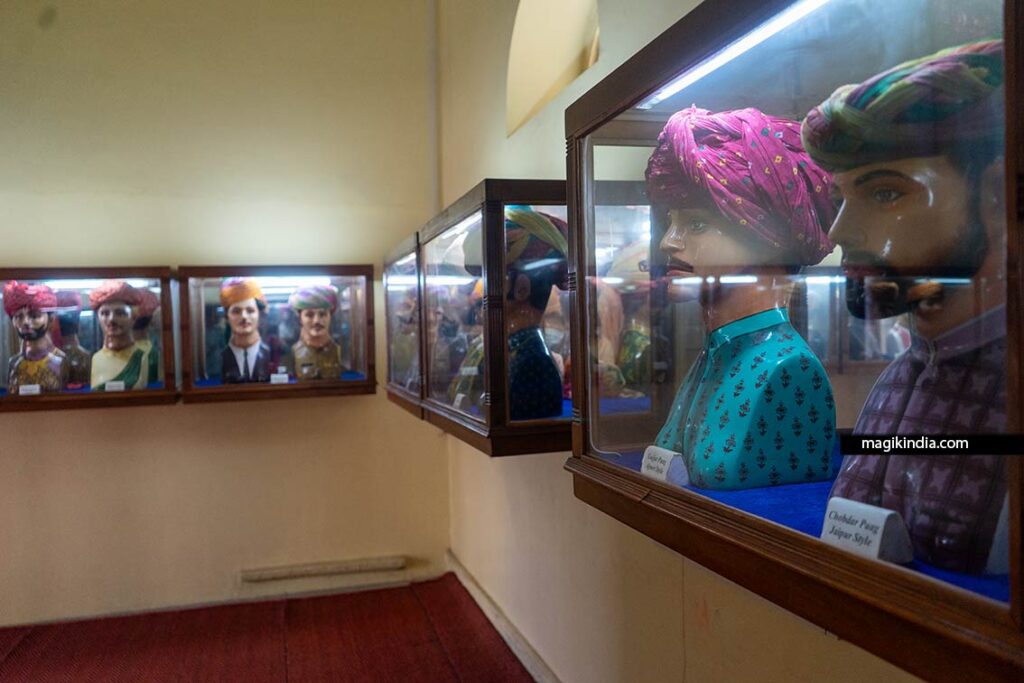
The Podar haveli also houses a museum divided into 22 galleries displaying various aspects of Rajasthani culture, including musical instruments, turbans, gems and jewelry, festivals and dances, bridal costumes, and miniature paintings.
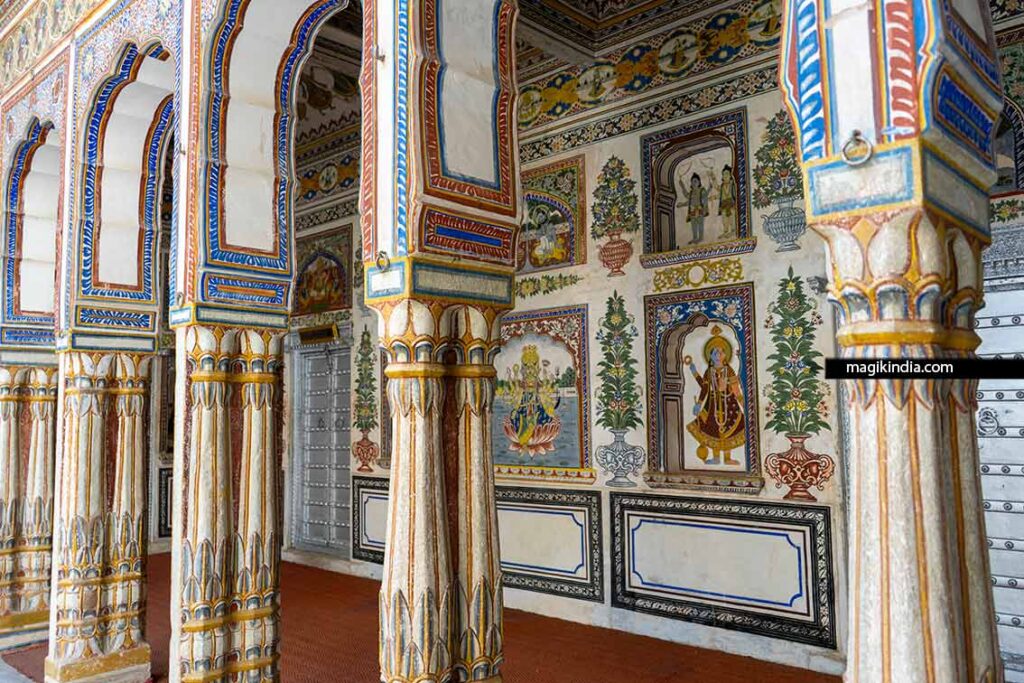
Morarka haveli
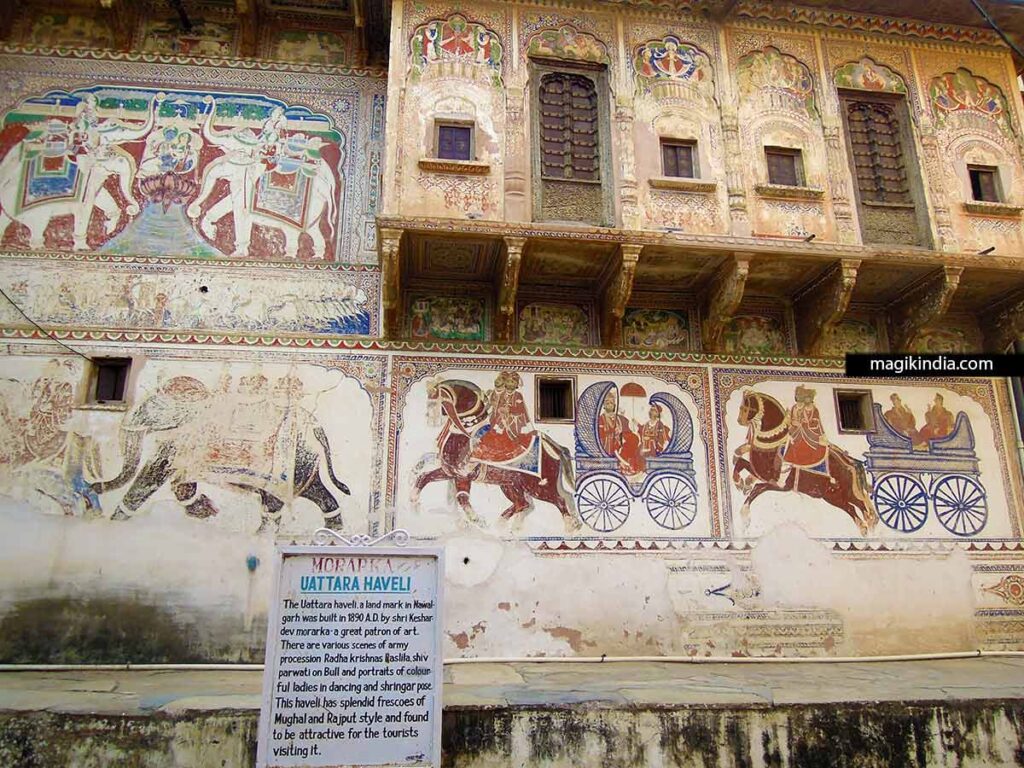
The Morarka haveli is a five-minute walk from the Podar Museum. This residence, although more rustic, is nonetheless charming. It was built in 1900 by Shri Jairamdasji Morarka, a connoisseur and patron of the arts. His descendant, Kamal Morarka, is currently the owner.
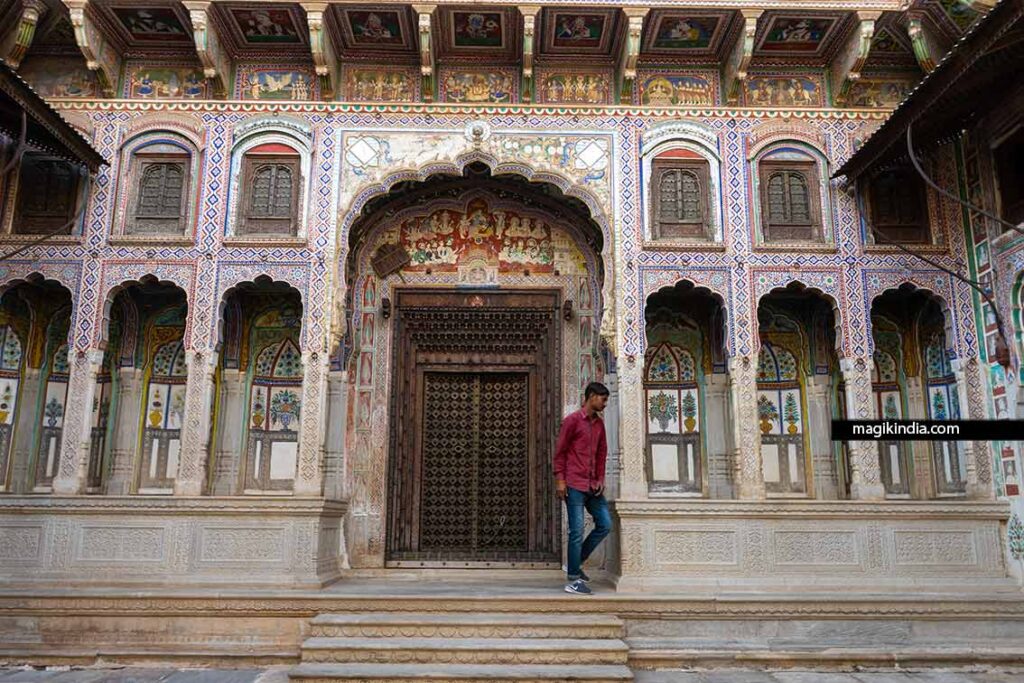
The haveli’s frescoes are painted in shades of indigo blue and red with touches of green. They depict the leelas of Lord Krishna as well as the great Indian epics.
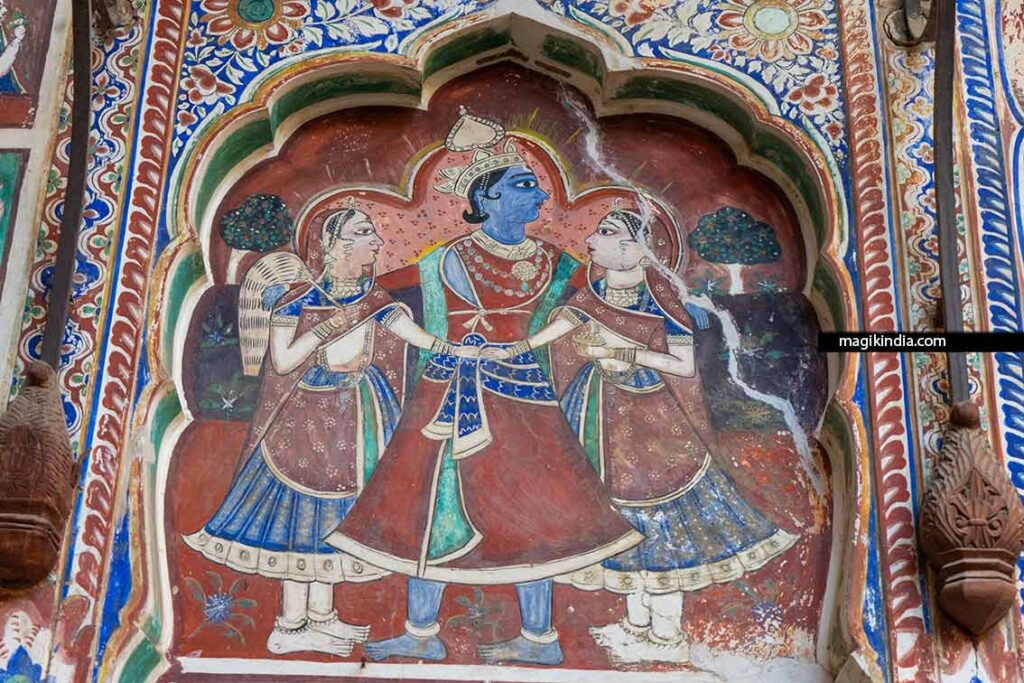
Its unique feature is its two portraits of Jesus Christ (one inside and one outside); it is one of the few houses in Shekhawati where a portrait of Jesus is painted, the second being the Bhantia haveli in Churu (in the north of the region), which depicts Christ smoking a cigar, an insolence in protest against the British occupation.
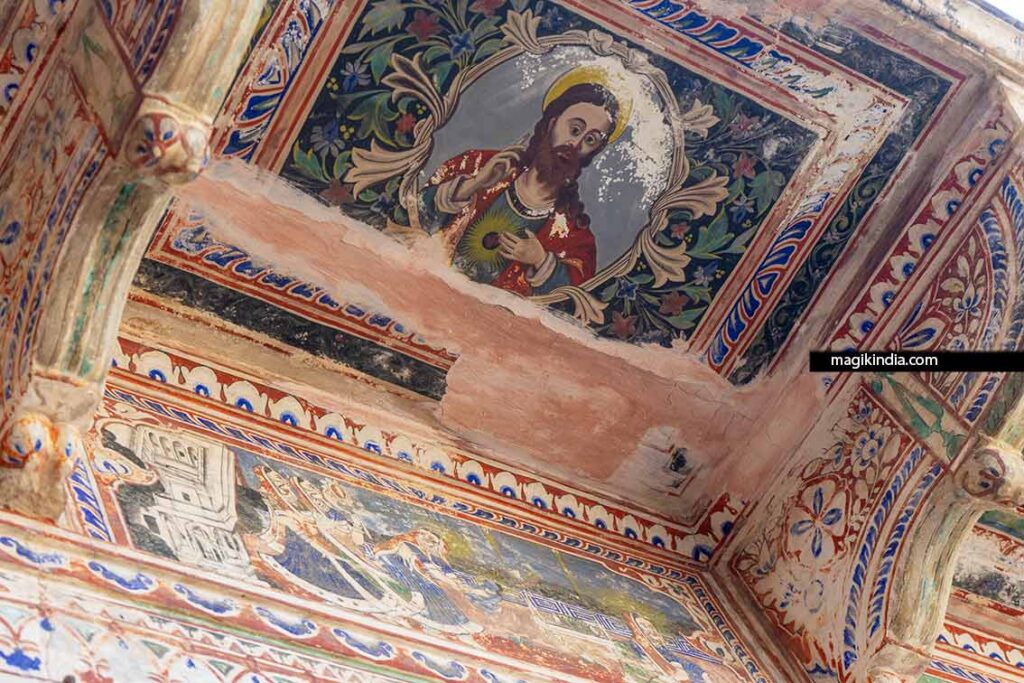
Bansidhar Bhagat Haveli
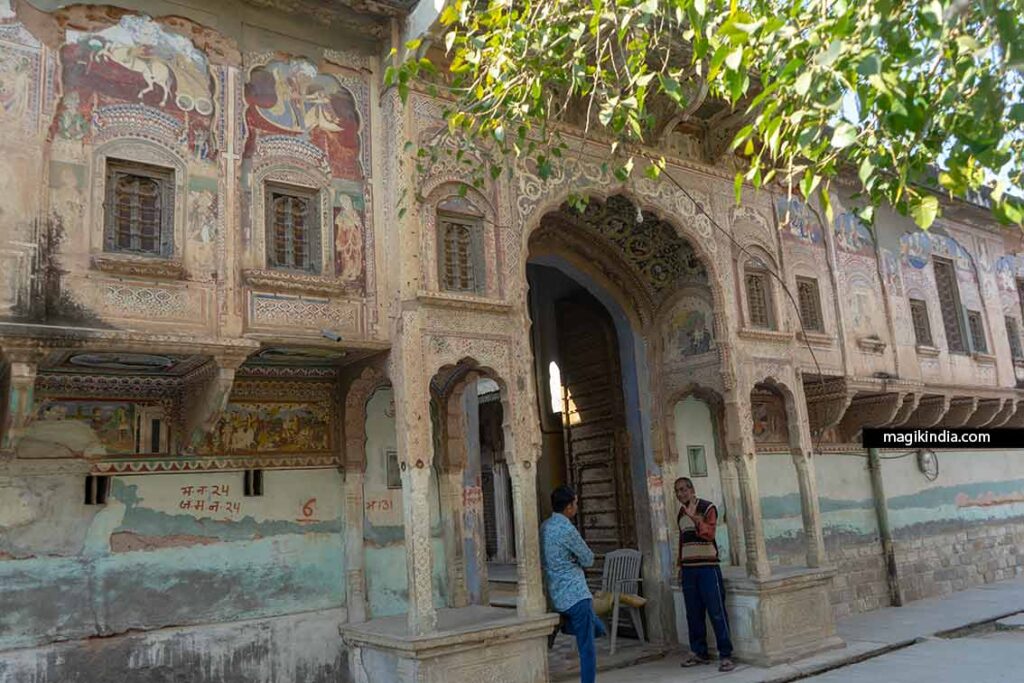
Bansidhar Bhagat Ji Haveli is arguably the most refined in all of Nawalgarh. Its entrance is rather plain compared to the two previous havelis, yet its interiors are exquisitely refined. Bansidhar Bhagat Ji Haveli was built by the businessman of the same name in 1890.

First remarkable element: the entrance door of the second chowk (courtyard) where one can see, above the lintel, the marriage ceremony of Lord Krishna and Rukmini.
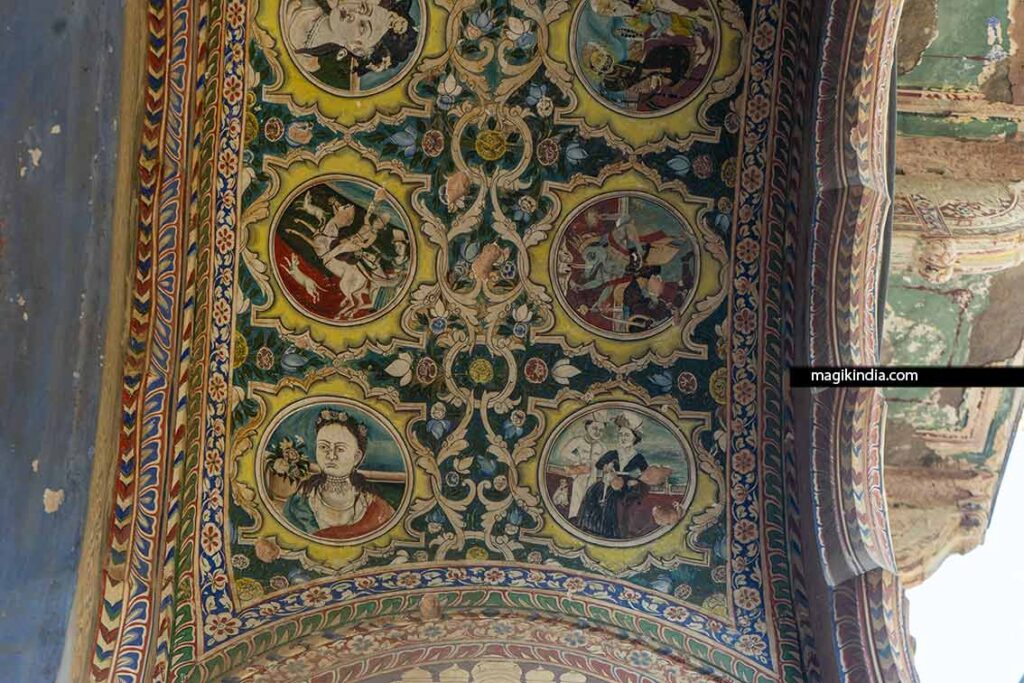
The haveli is also famous for its portraits of notables and various foreign figures. Among these, one of the most notable is that of the Mexican painter Frida Kahlo. The Marwaris, through their business, were in frequent contact with the West; they liked to display their open-mindedness and love of art through the diverse architecture of their homes.
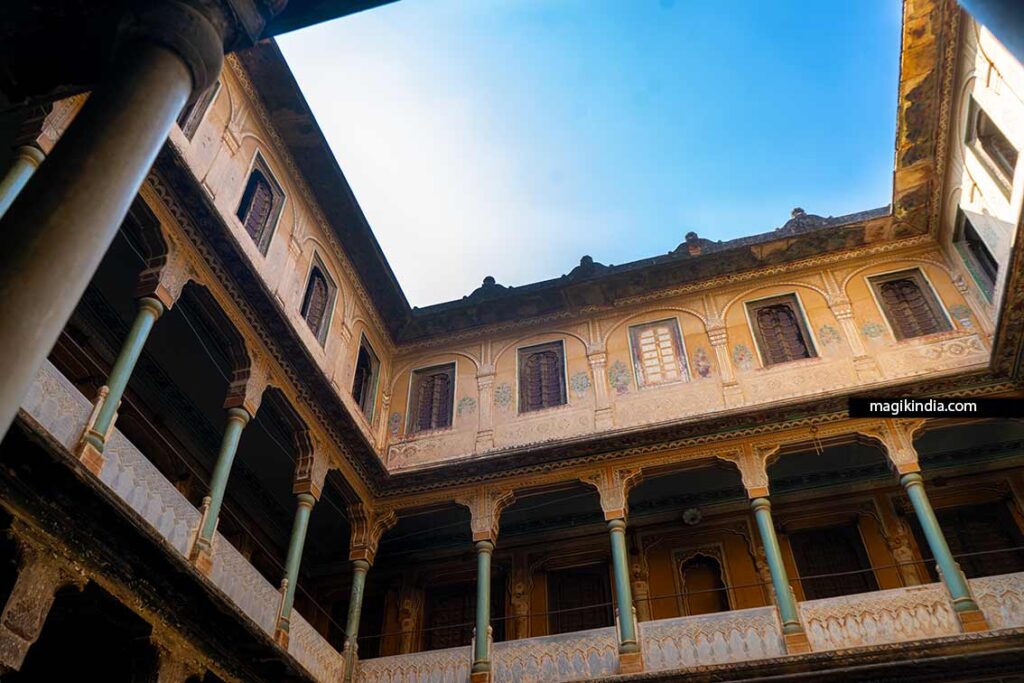
Thus, in the Bansidhar Bhagat Ji haveli, the Italian influence is perceptible. The second courtyard and the rooms on the second floor display a Renaissance style with ochre and blue colors and trompe-l’oeil columns.
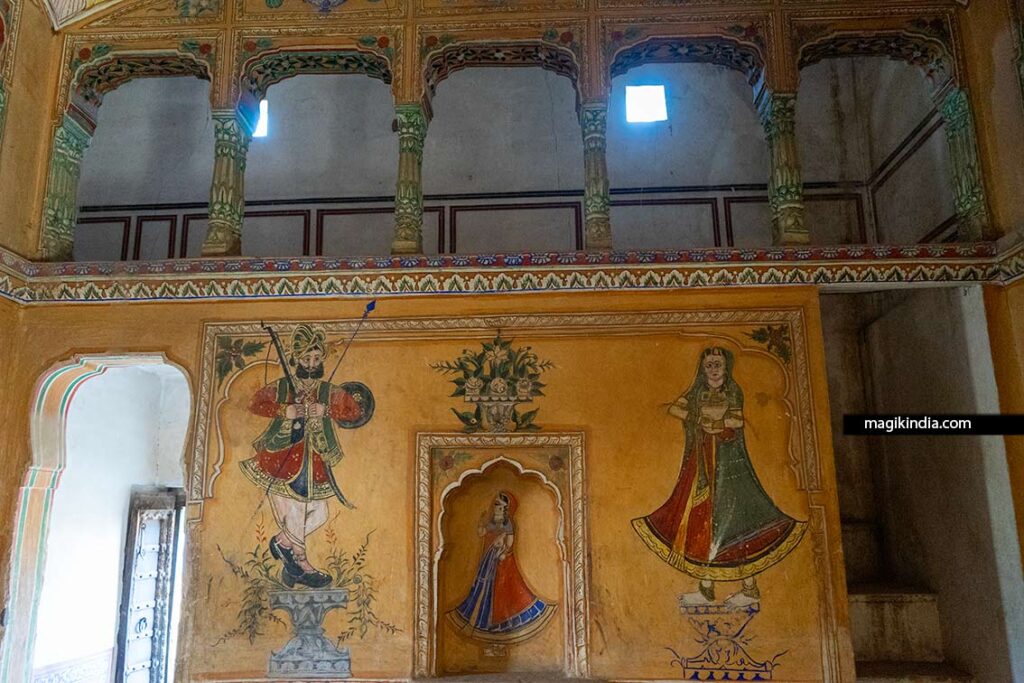
Like the other havelis of Shekhawati, frescoes representing new means of transport are painted in several corners of the Bansidhar Bhagat Ji: boats and steam trains rub shoulders with Vishnoite frescoes.
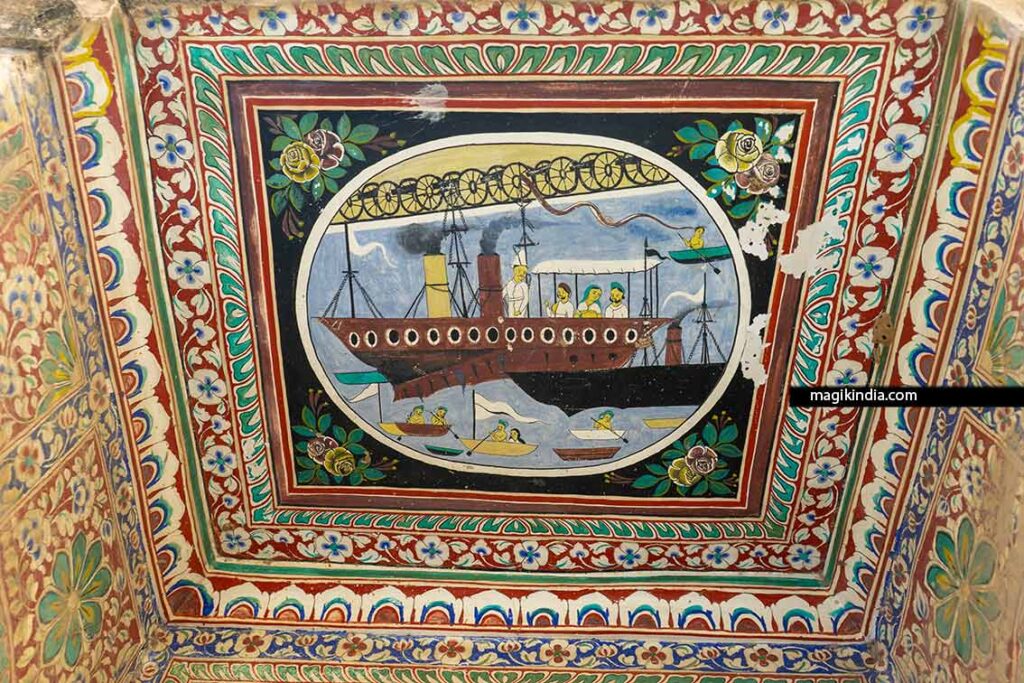
Aath Haveli
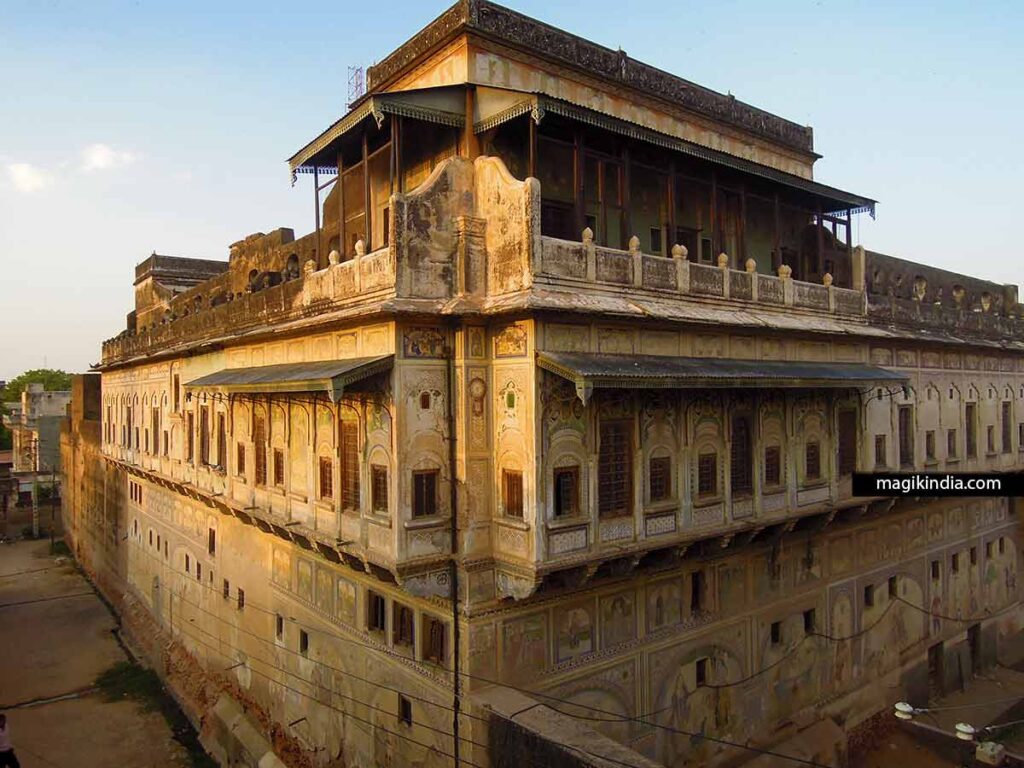
A short walk from the Bhagat haveli, we come across a vast mansion comprising a complex of eight havelis, hence its name “Aath haveli,” “aath” meaning “eight” in Hindi. Although it is not open to the public, it would be a shame not to mention it, so grandiose is the building. The exterior walls also feature remarkable frescoes painted with their original pigments in shades of green.
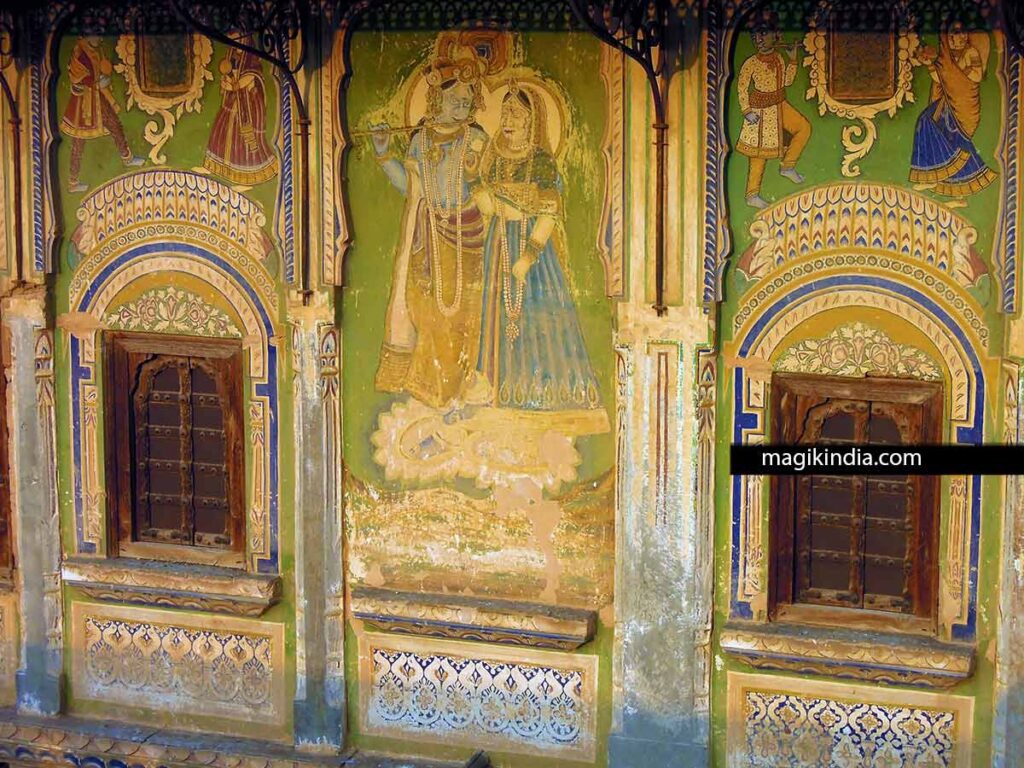
It features images of Indian deities and contemporary elements such as a steam train arriving at the station, a recurring motif in the havelis of Shekhawati, proof that the Marwari merchants were not only faithful to Hindu traditions, but also had an eye towards the future and modernity.

Nawalgarh temples
Gopinath ji & Ramdev ji Mandir
These two temples are the most important in Nawalgarh.
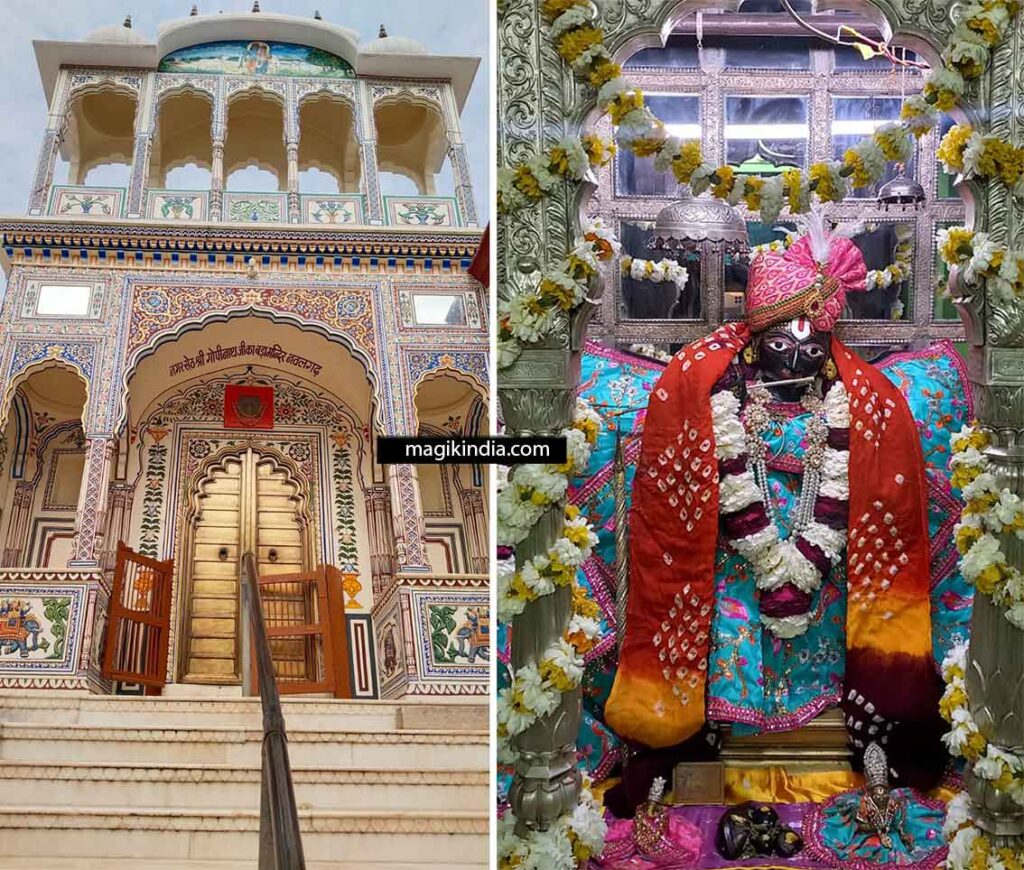
Gopinath ji is the oldest temple in the city, built at the request of Nawal Singh Ji Bahadur, the founder of the city; it is therefore approximately 300 years old. The temple is located in the city’s main market square, behind the Ganesha temple.
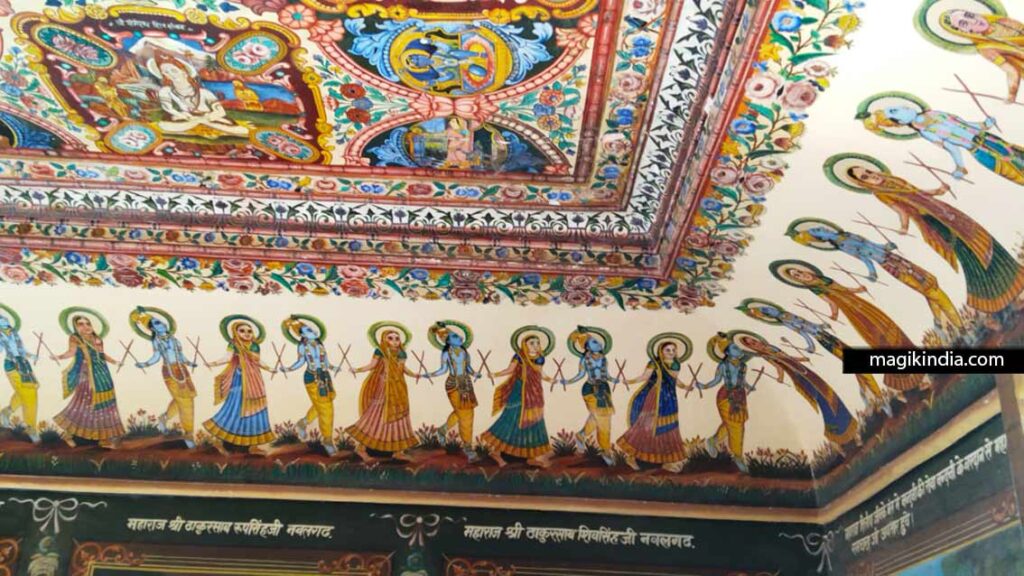
As its name suggests, this temple is dedicated to Krishna and his gopis. The sanctum houses three black sandstone statues: Lalita Shaki on the left, Krishna in the center, and Radha, his beloved, on the right. Lalita is one of the “Ashtasakhi,” that is, one of the eight eminent gopis, along with Vishaka, Champaklata, Chitra, Tungavidhya, Induleka, Rangadevi, and Sudevi. These eight gopis are considered an extension of Radha.
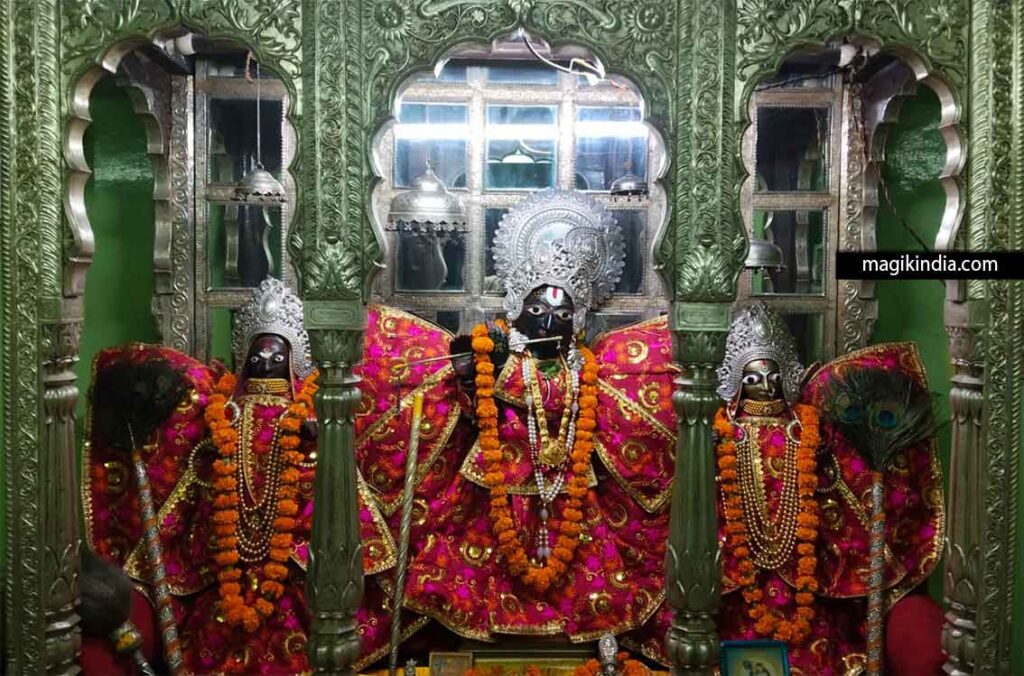
The temple features beautiful frescoes depicting, among other things, the Raas Leela, the divine ecstatic dance of Krishna and the gopis, and scenes from the Ramayana.
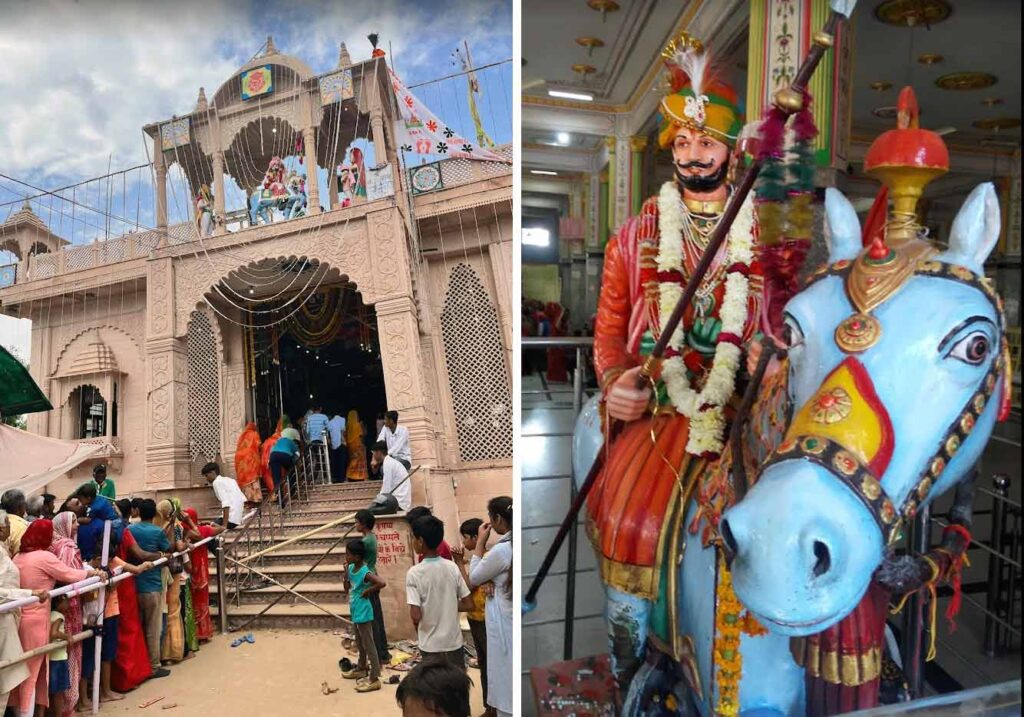
The Ramdev Temple is located in the far south of the city, and takes about 20 minutes to reach from the market. The walk is pleasant, passing through several typical shopping streets lined with mansions such as the Parasrampuria haveli, another example of Nawalgarh’s former magnificence.
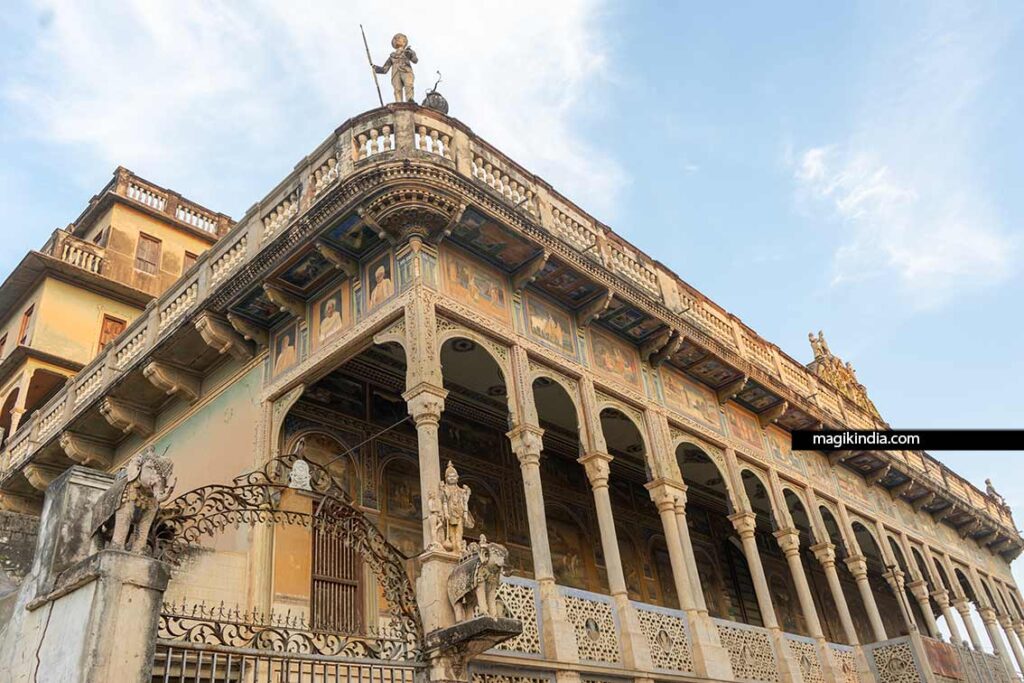
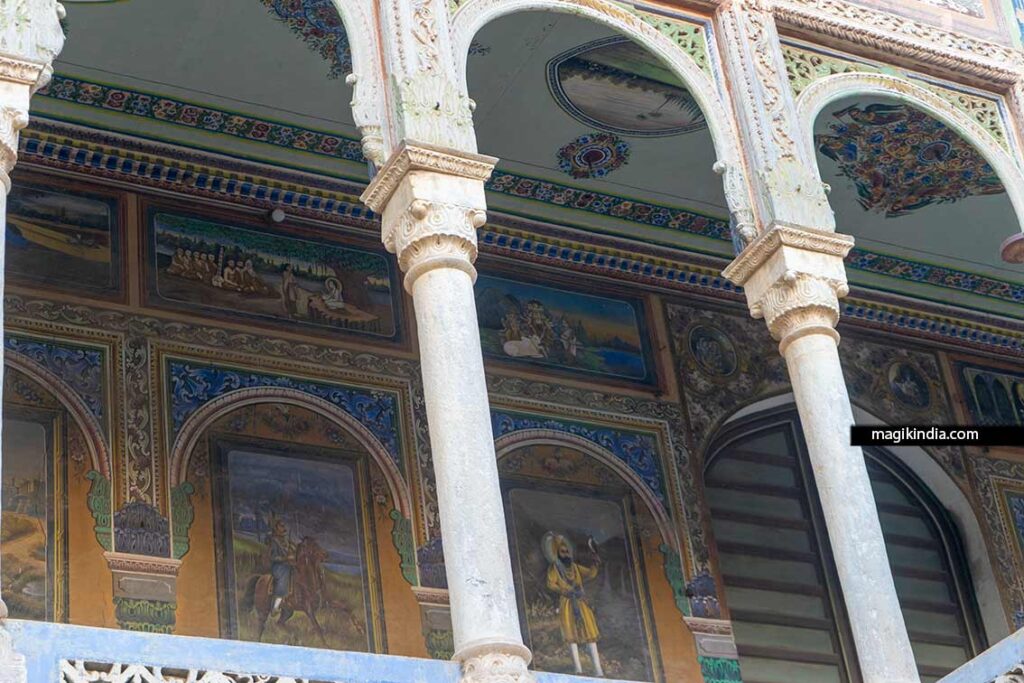
Ramdev ji was a 14th-century Rajput Tanwar lord born in the Pokhran region near Jaisalmer. Due to his miraculous powers and exemplary life devoted to the poor and oppressed, he was elevated to the rank of saint by the faithful.
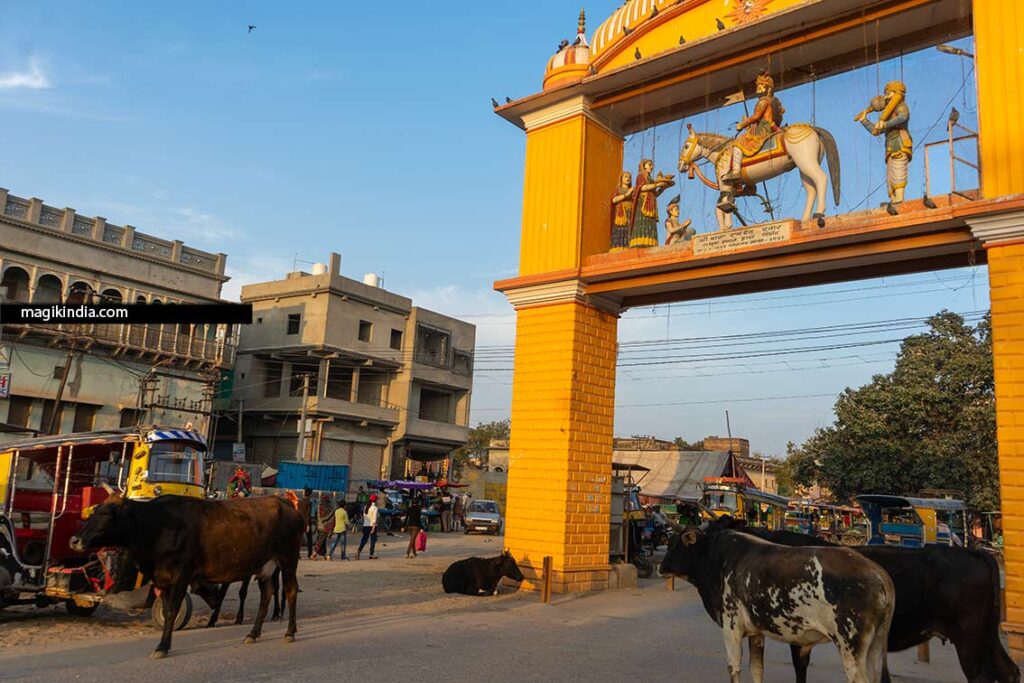
Ramdev ji is often depicted on horseback, and his worship transcends Hindu-Muslim and caste divides. While Hindus consider him an incarnation of Lord Krishna, Muslims worship him as Ramshah Pir. In the Sufi tradition, the term “pir” is used to refer to a person who serves as a mentor or guide to spiritual aspirants.

Opposite the temple, you can see a “kua,” a well topped with four minaret-like towers, unique to the Shekhawati region. See my article on these special wells.
Gher ka Mandir
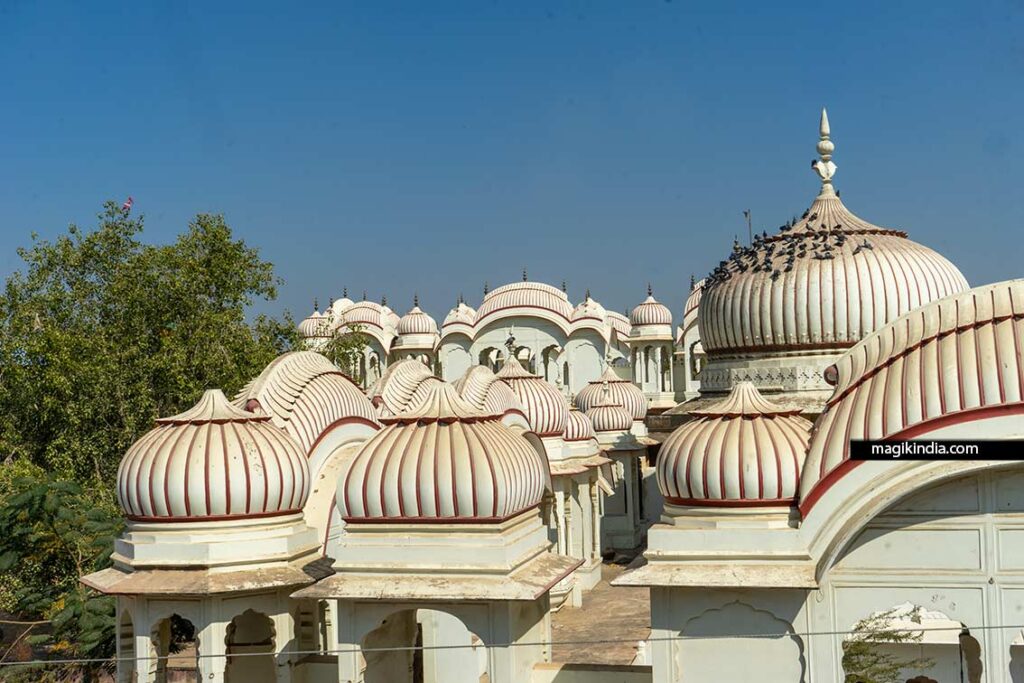
My favorite! The Gher Temple is located directly opposite the Morarka haveli. Built in the 18th century by the Chokani family, its multiple domes resemble a small palace from Arabian Nights.
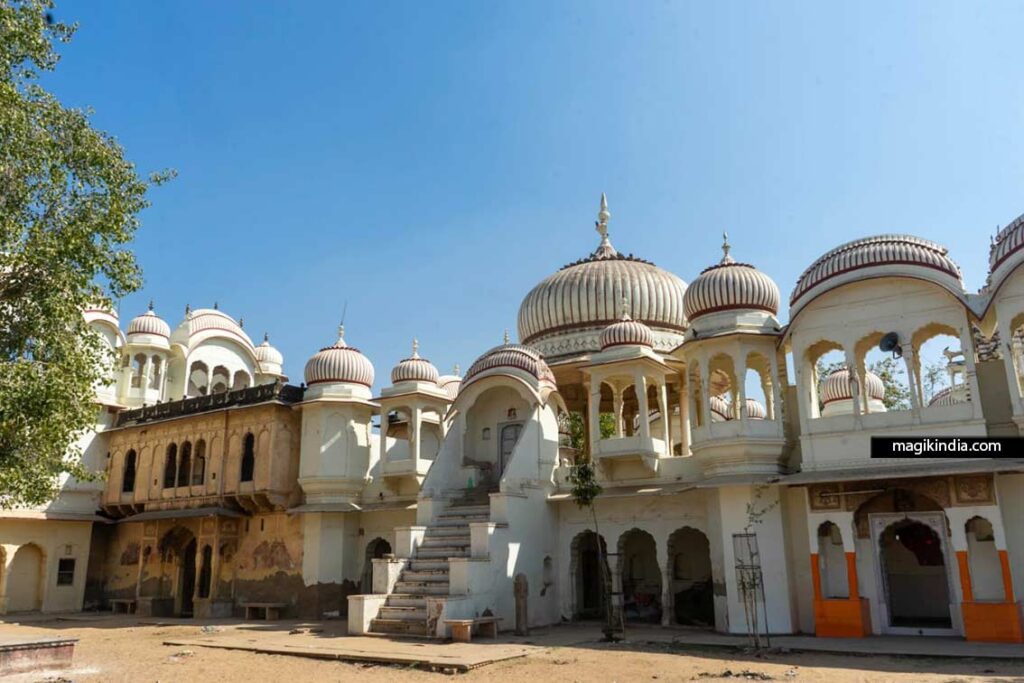
It houses two sanctuaries dedicated to Krishna (Dwarkadeesh and Radhakrishna) and another to Shiva where 11 banalingams, brought from Omkareshwar, are arranged.

This temple complex was recently renovated and repainted white. It was once adorned with frescoes similar to the havelis of Shekhawati. Only a few sections of wall still retain their original paintings.

Kalyan ji ka mandir
Perched high on the main road leading to Nawalgarh’s central market, Kalyan Temple is well worth a visit. It is only open to the public for a few hours in the morning and evening. It was built in the 19th century by Thakur Mukund Singh of Mukundgarh, a 20-minute drive away.
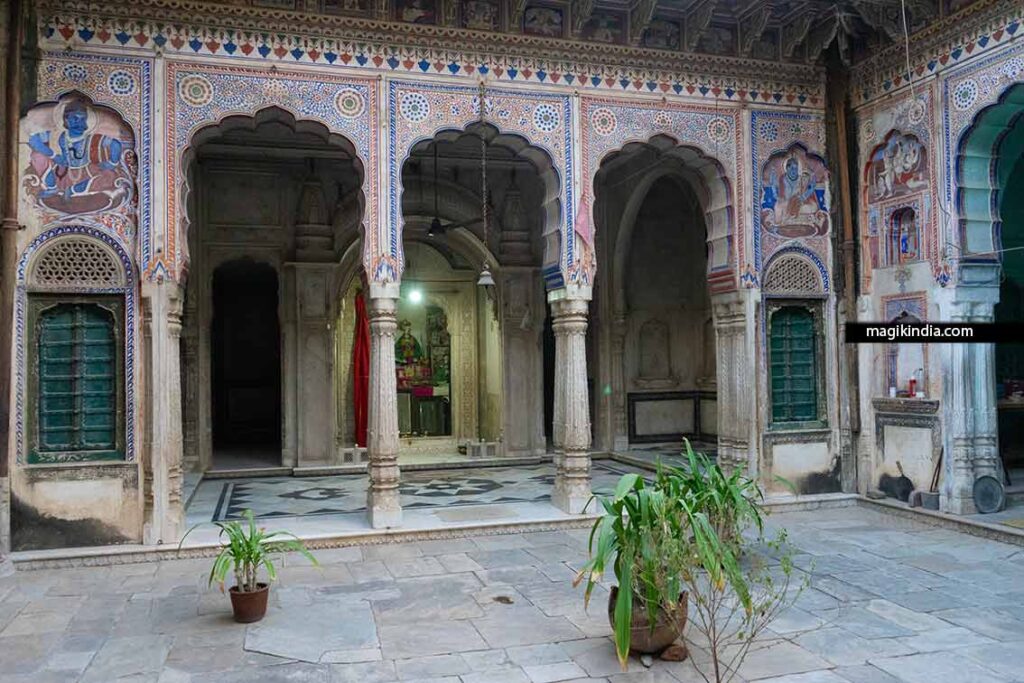
The temple dedicated to Radha-Krishna is painted in the same tones as the Morarka haveli. It depicts scenes from the life of Lord Krishna and in the middle of these, a beautiful image of Lord Shiva seated in a royal manner, telling a mala (rosary).

A few treats before finishing the tour!
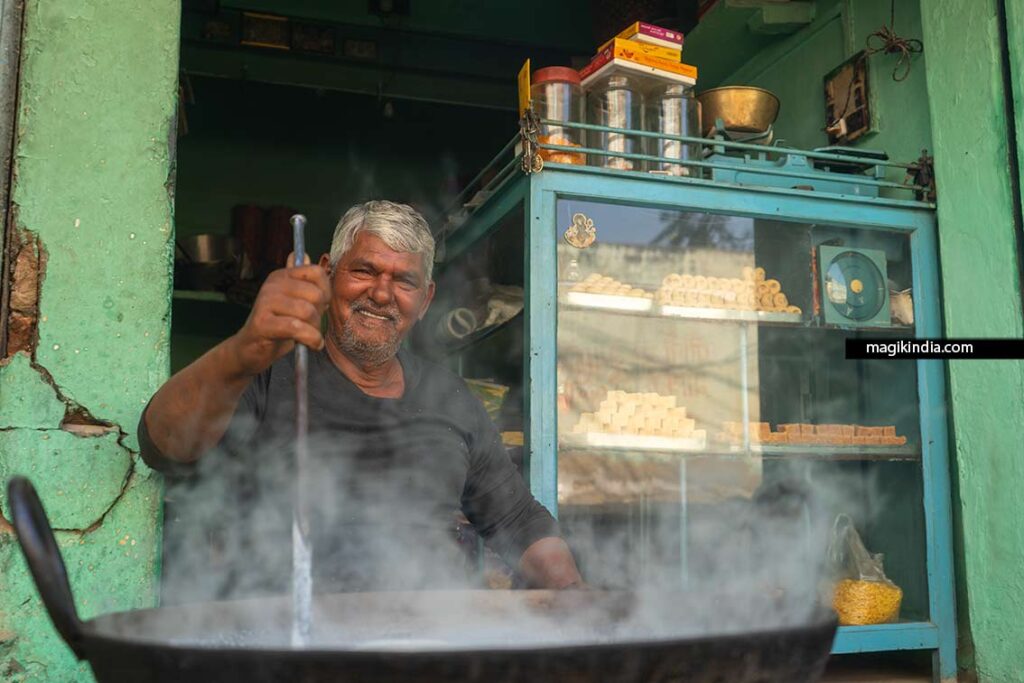
The city has its own culinary specialty, “Rajbhog,” a dessert that is more or less similar to the Bengali rasgula, with a major difference in color and texture, rajbhog being brown and drier. This paneer-based dessert was usually prepared for kings and during festivals, hence its name “the food (blog) of kings (raj).”
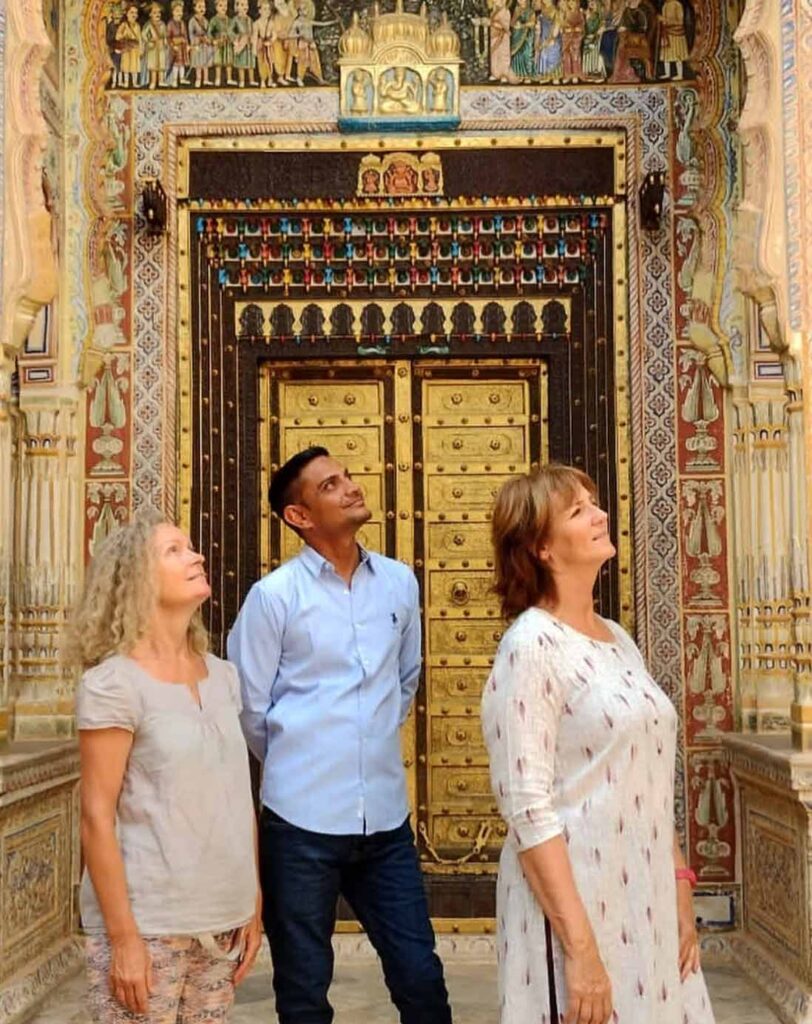
Dinesh Sharma, a native of Nawalgarh, is one of the best official cultural guides of the Shekhawati region and the co-director of MATHINI TRAVEL. With over 10 years of experience in the tourism industry, there’s no corner of Shekhawati that escapes him. He’s eager to share his passion for this unique region of India with you.
Whatsapp:+91 9509122902

